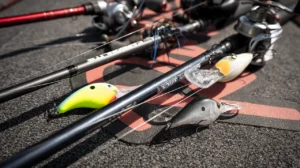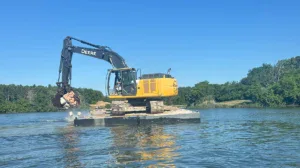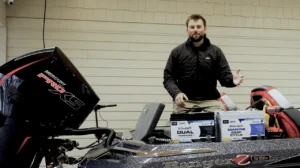The phrase “terminal tackle” has always implied, to me at least, that the piece of tackle in question is one and done; it’s simply meant to be used once and discarded. But lots of this stuff can be reused, from beads, swivels and clips all the way to the obviously expensive tungsten weights that are technically terminal tackle, but products no one would obviously throw away after one use.
So today, we’re going to look at creative ways to reuse some terminal fishing tackle that you might have otherwise trashed in the past. We’re also going to discuss ways to better protect high-end terminal tackle so it can be used time and time again. Finally, we’ll even dive into how to decide whether some terminal tackle, like hooks for instance, are worth trying to salvage for future use.
Once-thought trash
In preparing for this article, I tried to think of terminal tackle I’ve trashed in the past that I ran out of later and didn’t have when I needed it. Beads, swivels, split rings, clips and even bobber stoppers came to mind. With most of those little pieces, it’s all about intentionality. With beads and swivels for instance, when I’ve cut off a Carolina rig in the past I’ve had a tendency just to throw those little pieces away with the leader. But in just a few seconds I could have clipped the line off, dried them and stuck them back in my box.
Since I rarely use a Carolina rig, I rarely think about my inventory of these little pieces and I’ve found myself out of stock a couple times over the years, on the rare occasion I actually could have used them. But for bobber stoppers, I thought to myself, “How could I reuse these? Would it even be worthwhile?”
As it pertains to money, probably not. But when you run out of bobber stoppers on the water, it can be quite annoying. So the thought came to me that I might be able to reuse a bobber stopper using a small sewing needle.
The trick here is to find one with an eye large enough for your line, but not so large that it’ll tear the rubber bobber stopper. Then simply run your line through the eye of the needle a few inches, pull the needle through the bobber stopper and then pull the line all the way through with the needle. Lubricating the needle first will make this a smoother process as well. Another trick is when your spinnerbait is no longer useful, you can still salvage split rings, beads, clevises and swivels from them by clipping the blade arm of the spinnerbait and sliding these pieces off.
Gauging what to keep
We use a lot of hooks, shaky heads, Ned heads and swimbait heads now that are technically lumped into the “terminal tackle” genre. But many of these can, and most should, be used multiple times. The main thing you want to do if you’re considering keeping these around for a future trip is to check the integrity of the hook. First, make sure the hook hasn’t been bent out. If a hook is opened up beyond its original bend by a fish or perhaps from being hung, the strength of that bend has been compromised and the hook will bend again much easier the next time. So in that instance, the hook’s not worth keeping since you can’t trust it when you set it.
In addition, you’ll want to check the hook point. You can usually conduct a visual test by looking at the point of the hook to make sure it hasn’t rolled over, meaning bent right at the tip. You can also, very carefully, check the point of a hook with your thumbnail, applying a little pressure to see if the hook point starts to dig in or scratch the surface. Again, do this GENTLY. If the hook is sharp, there won’t be much pressure required. If it’s dull or the hook point is rolled, toss it out.
How to store salvaged terminal tackle
Whether you’re planning to reuse hooks, spinnerbait components or high-end tungsten weights, there’s a process to storing your previously used tackle. Rust, corrosion and other damage can occur with not only the terminal tackle you’re trying to salvage, but also all the new terminal tackle that’s already in your box. You must first and foremost ensure that the tackle is completely dry before you put it up. I like to leave these items out for a while before putting them back in the box if possible.
You can dry them with a rag or paper towel after a trip if there was rain present that wouldn’t allow for air drying the tackle. And it’s not even a bad idea with some terminal tackle to use a little oil to ensure rust and corrosion don’t creep in. If you’re afraid of the smell oil will leave on them, use oily fish scent in place of an oil like WD-40. You won’t need much, but a quick spray or a drop or two will help keep rust at bay. There are also products like Bull Frog Anti-Rust Emitter Shields and Flambeau’s extensive lineup of Zerust products specifically designed to help combat rust. But even with these preventatives in place, don’t just throw a wet hook right back in the box.
As for painted terminal tackle like jigheads and tungsten weights, it’s a good idea to store them in a way where they can’t make contact with one another. You can do this several different ways: keep the original packaging handy, use foam to separate the terminal tackle or you can even wrap the weights in plastic or bubble wrap to keep them from banging into each other. This may seem a bit excessive, but if you spend 15 bucks on a 2 1/2-ounce painted tungsten punching weight that you’ll only need a few times a year, you don’t want to go looking for it a few months later and see a beat, battered and chipped up paint job.
In conclusion
“Terminal tackle” is a phrase we should use loosely these days. Lots of this stuff can be used time and time again, some year after year. Deciding what to keep and what to let go is a case-by-case deal. There’s no need to recycle every bobber stopper for instance, but keeping a sewing needle in your box will extend the life span of those last few until you can restock. And when it comes to anything with a hook in it, make sure the bend hasn’t lost its integrity and the hook point is still sharp and you’re good to go there.
Whatever you decide to save, make a serious effort to dry it off first. Then use preventative methods like rust inhibitors or perhaps a little oil to keep rust and corrosion at bay. Lastly, once you take those high-end painted products out of their original packaging, you gotta protect that paint job. Use foam or plastic to either position the tackle to where it can’t touch other hard surfaces or even wrap it up to create an extra layer of protection. Using these tips, hopefully you’ll be able to stretch your dollar further, stress less and get more out of your terminal tackle this season.


















